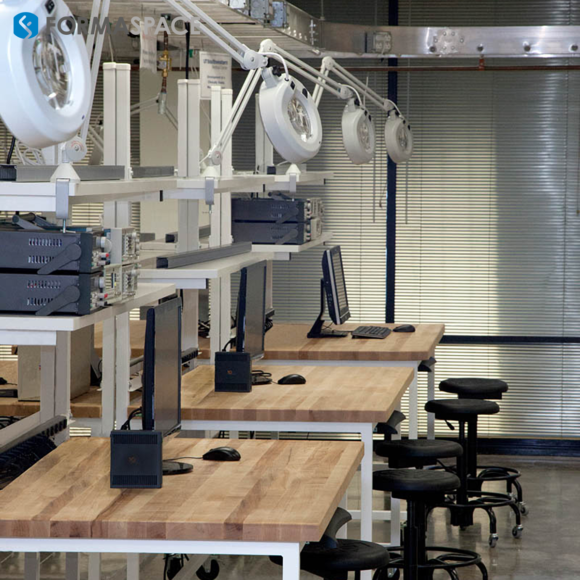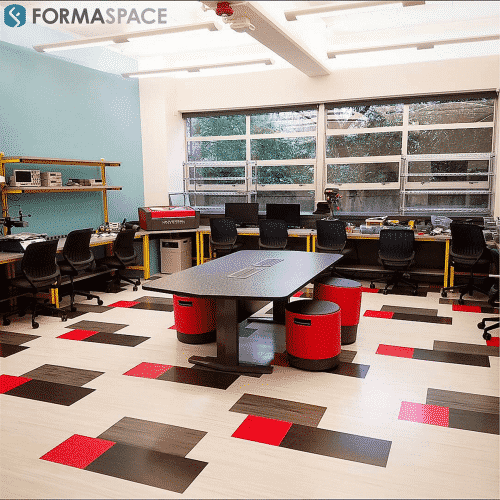In their recent forecast of emerging market trends in 2021, the consulting giant Deloitte predicted that the fastest-growing market for digital reality products and services (defined by Deloitte as Virtual, Augmented and Mixed Reality) will be the enterprise and education markets, driven by the rapid adoption of virtual training applications.

In keeping with this trend, many virtual reality (VR) developers are targeting medical schools, where they are finding a welcome reception for new virtual reality-based training products.
We’ll take a look at what facility planners, architects, and designers need to know about this fast-growing market, as well as provide tips on how to accommodate VR lab studios when planning new construction projects or major renovations at medical schools.
We’d also like to thank Oguz Ormanci, the founder of Opus Visual, a Houston-based VR company with developers based around the world, for providing his insight into this fast-growing market.
Key Benefits of Using VR-Based Training Applications in Medical Education
Why the rapid uptake of VR-based training by medical schools?
The answer likely lies in the storied history of simulation training at many leading med schools, which pioneered the use of Simulation-Based Medical Education (SBME) tools and personnel.
Dedicated SBME centers in med schools have been at the leading edge of created realistic simulated environments long before virtual reality appeared on the scene.

For example, SMBE innovators pioneered the use of realistic human mannequins with functioning prosthetic body parts that allow students to practice examination procedures, life-saving emergency room procedures, and even simulated surgical operations.
SMBEs have also long relied on the employment of human “simulated patient” actors who help train young medical students on how to conduct one-on-one patient encounters – well before they ever meet their first live patient.
It’s in this spirit of innovation that leading-edge VR applications have found a welcoming audience among SMBE professionals, who can appreciate many of the benefits that well-designed VR-based simulation tools can offer in medical school training, including:
1. Creating a safe, simulated environment for students to learn new skills and techniques – and even make mistakes – without the consequences of interacting with a live patient.
2. Improving patient outcomes by allowing students (or practicing doctors returning to learn a new technique) to gain experience and build expertise through targeted training applications; for example, learning new surgical techniques.
3. Providing educators with a way to perform direct formative and summative skill assessments of a learner’s progress, which can be difficult when relying on written tests or other traditional assessment methods.
4. Reducing costs in many cases, for example, by allowing students to practice at their own pace without driving up the labor costs of instructors or staff.
5. Allowing students, even those located thousands of miles away, to work together in a virtual environment and learn from each other.
What is the State-of-the-Art in VR Training Applications for Medical Education?
From a facility planning point of view, we can divide the VR market into two broad categories.
The first category is the high-fidelity VR market, one that offers users (who wear specially designed headsets known as VR goggles) a full-immersive, photorealistic representation of the world.
The goal here is to provide as much realism as possible, to make a convincing experience for the user, by providing real-time, high-end game-quality visual environments with haptic (touch) feedback, for example, when handling a virtual tool, such as a scalpel in the case of a surgical training simulation.
This real-time immersive experience comes at a cost, however. It requires a major capital investment to acquire and maintain the sophisticated computer graphics hardware and the high-end headsets worn by the users, as well as the cost to develop or acquire the software running the training simulation.
(We’ll address the hardware and software budgets shortly, with updated information provided by Oguz Ormanci.)
High-fidelity simulations have their place, but educators have also found quite a few training simulations can be accomplished with economical, low-end consumer-grade headsets, including the barebones Google Cardboard headsets, which, as the name implies, are literally made out of folded cardboard with a cubby hole to insert a smartphone which serves as the screen.
Sadly, Google recently discontinued making the Cardboard headsets, but other vendors have stepped in with inexpensive consumer headsets.
These low-powered systems don’t offer the same level of realism, so users won’t feel as if they are in a fully immersive environment, but for many well-designed training applications, it’s quite sufficient.
The advantage of these “cheap and cheerful” (to borrow an expression from the Brits) low-cost VR systems is that they can be deployed widely – using ordinary high-speed internet connections, which offer students access to VR-based learning tools from the comfort of their home, dorm room, classroom, or student laboratory. They also open up the opportunity for students from around the world to work together in the same VR simulation in a 3D version of a Massive Open Online Course (MOOC).
VR Lab Studio Space Planning and Staffing Strategies

If you an architect or designer working on a medical education facility project, be it a brand new facility or a major remodel, you’ll want to include space for a VR Lab in your programming proposals – even if your client doesn’t have immediate plans for a VR implementation.
Where to locate the VR lab within the educational institution is an interesting question in itself.
As a new technology, a VR lab could “fit” within one or more different organizational departments.
The ideal location will depend on the client, including whether they are starting from scratch or if they have the option of leveraging existing facilities and/or staff talent. Also important is whether it’s a high-end VR solution or a low-end solution, as the hardware and space requirements are different.
Here are the most common departments that could “own” a VR lab in a medical education setting.
1. Simulation Center
Many medical schools have or are in the process of creating dedicated SBME facilities to educate medical students, and these can be the ideal location for siting a new VR lab.
For example, the new Health Education Center at UTMB features a working ambulance dock, two simulated operating rooms, ten ICU rooms, over 30 private exam rooms – all dedicated to creating a simulated hospital environment for training med students. In planning this new facility, a large portion of the main floor was set aside for the development of a future VR lab.
In such a simulation center, the medical training staff could be leveraged to conduct VR-based training, but additional technicians would need to be brought in to service and maintain the advanced VR lab equipment.
2. Desk-Based VR maintained by the Help Desk
At the other end of the spectrum are low-cost headset-based systems that can be provisioned and used anywhere that has access to high-speed internet.
In this scenario, it’s plausible to leverage the existing Help Desk services to provide technical support for the students and instructors.
3. Library
Another candidate department suitable for “hosting” a VR lab is an educational institution’s medical library, which has extensive experience in sourcing, maintaining, and organizing access to materials and equipment used by instructors and students.
At institutions such as Georgetown University, library personnel manage loaning out off-the-shelf software applications and low-cost hardware applications to students and faculty.
Given their skill sets, libraries are now often becoming the designated “owners” of more ambitious VR lab studios – but they will need access to the necessary technical staff to support the studio equipment.
4. Innovation Center
An increasing number of medical schools are also creating their own startup incubators to help transform research projects into commercial ventures.
For example, the Texas Medical Center is expanding beyond its first innovation center, TMCx, to create an even larger complex, dubbed TMC3.
In this scenario, corporate sponsors could help fray some of the capital costs of getting a new VR lab up and running within an Innovation Center.

5. Media Studio
Many of the largest medical institutions have already heavily invested in media studios to create promotional and education materials, including video content.
In some cases, it would make sense to expand the role of a media studio department to incorporate a future VR lab.
As in the case of libraries or innovation centers, media studio personnel would need to be augmented with technical and instructional staff to create a complete VR Lab team.
6. Computer Training Classroom
Existing computer-based training laboratories are another possible host for a new VR lab, thanks to their ability to leverage existing technical staff members who are familiar with managing classrooms with networked computer systems.
This approach also offers the possibility of sharing the cost burden with other departments, such as those in STEM-STEAM programs, including computer science software and game development programs.

7. IT Department
At some institutions, the IT department may want to “own” the newest technology and operate a new VR lab within their organizational structure.
In this case, it will be necessary to liaise with faculty and instruction specialists who work directly with the students.

8. Esports Facility
Thanks to the widespread popularity of computer gaming among students, Esports is an emerging phenomenon on many university campuses. Many schools are investing serious money into dedicated facilities to support this new sport.
Due to the similarities between VR applications and gaming technology, it’s worth investigating if these two programs could share some common facilities, hardware, or staff. (For more background on this, see our report on Esports.)
9. Rental Facility
Finally, it’s also important to do a “make or buy” assessment before investing in a new VR lab studio. Many new VR rental studios have come into the market to support educational and commercial clients.
And even if you ultimately intend to build a new VR lab on campus, it might make sense to try out a rental VR studio initially; to become better informed about what works and what doesn’t.
Budgetary Considerations for VR Lab Studios, including Space Planning, Hardware and Software Costs
We’d like to thank Oguz Ormanci, the founder of Opus Visual, a Houston-based VR company with developers based around the world, for providing his insight into this fast-growing market.
Space Planning for High-End VR Lab Studios
We’ve just addressed the different possible departments that a new VR lab studio could attach to. But what about the space requirements for a new VR lab studio space?
As we’ve mentioned earlier, low-end VR applications that use consumer-grade headsets (or even smartphone screens) don’t require dedicated space, as the users can typically run these types of low-fidelity VR applications at their desk, in the classroom, in the lab, or at home.
For high-fidelity VR training applications, however, users typically visit a dedicated VR lab studio, where they wear professional-grade headsets (e.g. goggles) that are tethered to a high-power computer by a length of cable.
For VR training applications that allow users to walk around (such as a simulation of operating in a surgical theater), you’ll need to provide enough physical floor space to allow the user to move around without running into walls or furniture.
How much space is needed is application dependent, as some apps allow the user to walk around within in a small area (say 10’ x 10’) while others might require the user to walk some distance while using the app (so-called VR “runs” at commercial VR labs can be as long as 50’ or 100’ in one direction).
Of course, you’ll need to double or triple these floor space dimensions if you intend to allow multiple users to wear additional headsets while co-participating in the same VR simulation.
Another space planning consideration is providing adequate support for instructor evaluation.
Many VR Lab studios include space for an audience, and in the context of medical education, the audience could be faculty members, course instructors, or exam evaluators, who would either co-participate in the activity with the student (by donning their own VR headset) or observe the student’s actions during the simulation by watching a full-screen video projection shown on the wall of the VR lab.
In addition to the video projection screens, most VR labs would also include video recording systems (either fully digital or DVD-based) to capture a student’s progress for later evaluation and feedback.
You’ll also need to provide space for all this computer and video equipment to operate (with ample, well-conditioned air to keep things running cool) as well as design a secure storage area to lock up the equipment (including headsets) when not in use.
Should you anticipate developing your own VR applications, additional space and computer equipment will be required to support a team of software developers and content creators. (More on that later).
Maintenance is another important consideration. You’ll want to make sure there is adequate room for technicians to perform maintenance on the computer hardware, including provisioning and testing new hardware.
Budget Planning for Low-End and High-End VR Hardware
Before we dive into the cost estimates for current VR hardware and available software, a word of caution.
The Deloitte report we mentioned earlier points out that their researcher found that spending by corporate training departments on hardware (such as headsets) only accounts for around 16% of the total cost of a typical VR-based training lab implementation.
Current generation low-end, consumer market headsets, such as the Oculus Quest 2 VR Headsets, are available at retail prices of around $300. At the high end of the spectrum, a professional-grade Varjo XR-3 headset costs much more. When you take into account the mandatory $1,500 annual support fee, a Varjo XR-3 headset will set you back upwards of $10k over a two-year expected lifespan.
Computer hardware budgets also vary significantly based on whether you are implementing low or high-end systems.
At the low end, many software applications can now be loaded onto a cloud-based server (such as Amazon’s AWS, Digital Ocean, or Linode). The advantage of this approach is that you can host users around the world and the cloud provider handles the details of managing the content delivery networks, and you can control costs by paying for “power by the hour”.
But many high-end, high-fidelity applications still require a powerful graphics computer located on-site inside the VR lab studio – one that’s connected directly to a user’s headset by cables. For budgetary purposes, you can plan on spending as much as $10k (or more) for a powerful graphics computer to run these types of applications.
It’s also important to note that the technology is changing rapidly – most VR hardware (and software, which we will discuss next) will be considered “obsolete” in only two or three years.
Be sure to have a “technology cascade” plan in place to make sure any older hardware finds a good home – either in another department or perhaps a non-profit institution that can benefit from using hardware that’s one or two generations behind the current state-of-the-art.
Budgeting for VR Software Applications
Remember Deloitte’s finding that hardware is only a small fraction of the overall cost of a VR implementation?
The major share of the investment is in acquiring, developing, and maintaining VR software.
Annual site licenses for commercial off-the-shelf VR training applications could range from $10k to $40k and up, sometimes way up. However, the alternative, custom software development, is generally significantly more expensive and requires longer software development timeframes, as we’ll see shortly.
Depending on your use case, you might get lucky and find a suitable, off-the-shelf VR application that can be sourced via an annual subscription or purchased outright.
Generally speaking, you’ll pay more for more mature applications; often in the form of expensive annual subscriptions or mandatory service agreements (obviously, an educational institution will want to negotiate volume discounts or a site license).
In some cases, you might find an open-source program that suits your needs.
Open-source projects are an appealing option for academic institutions. However, many open source projects lack the features of commercial products, such as robust quality testing or simple installation and upgrade procedures.
As such, many are considered “works in progress” that may require you to dedicate one or more of your developers or tech personnel to create a working implementation.
(BTW, it’s also important to be aware of the intellectual property agreements included in both commercial and open-source contract agreements to make sure you are not “giving away” any of your own IP as well as to avoid infringing on the IP rights of others in the future.)
This brings us to the custom VR software development budgets and timeframes.
According to Oguz Ormanci, founder of Opus Visual, “most organizations are not aware of the complexities of developing custom, high-fidelity VR applications, and they need to be educated about software development budgets as well as the timeframes required to develop and test a new application.”
Modern 3D graphics platforms, from companies such as Unity or Unreal Engine 5 (shown above), offer developers and content creators sophisticated tools to create realistic virtual environments that can be used to help students learn medical skills, ranging from human anatomy to specialized surgery skills.
Ormanci explains that while the underlying graphics technology, such as the new Unreal Engine5 platform, is very advanced and can create brilliant, photorealistic visual environments, it still takes a team of developers and content creators time to create quality VR-based training applications that are robust enough to work in a classroom.
As a result, custom VR-based software projects can often take a year or more to develop and can easily cost six figures or more.
Make Your VR Lab Studio Planning Process Part of a Larger Educational Goal
A final thought on creating a successful VR lab studio project.
Before you get caught up in the excitement of any new advanced technology, take a deep breath and consider the educational and training problems you are trying to solve.
Like all new technologies, VR is exciting. But it’s also important to consider how it fits into the larger ecosystem, including the points we’ve discussed above, such as how VR technology syncs up with existing departmental structures and staffing roles, as well as budgeting for the necessary space, storage, maintenance, and acquisition costs involved.
It’s also important to investigate other aspects beyond the scope of this article, such as determining the optimal ways to integrate VR-based training with your existing pedagogy models and training curriculum.
Taking this larger worldview approach will help make your VR lab studio project a success.
Formaspace is Your Partner for Modern Educational Learning Facilities
Want to learn more about how to create successful learning environments?
Talk to your Formaspace Design Consultant today.
They are happy to share our years of experience building educational learning environments, school laboratories, and makerspaces at some of the most prestigious universities (including Harvard, Yale, and Cornell) as well as leading K-12 school districts around the country.
If you can imagine it, we can build it, here at our Austin, Texas factory headquarters.
Formaspace furniture is made in the USA and is available through Federal GSA contracts as well as the TIPS Purchasing Cooperative used by many local governments and school districts.




















